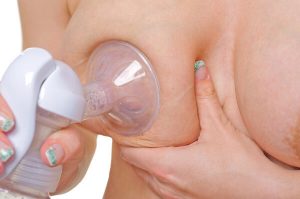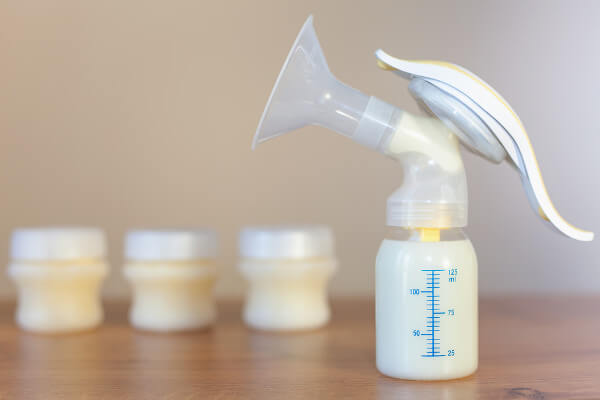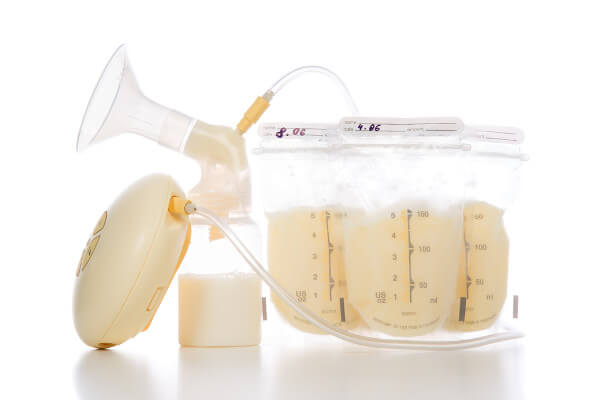How to Properly Extract and Store Breast Milk

Learning to extract and store breast milk has many advantages. Having breast milk that has been correctly stored can be extremely helpful in case you need to be away from your baby.
If you need to be separated from your child for a long period of time, then knowing how to extract your own milk will also relieve the pain caused by accumulated milk in your breasts.
There are several ways to extract your milk and to save it afterwards. First, you must keep in mind that breast milk pumps extract milk from a mother’s breasts in a simple way that does not cause pain. Therefore, there is no need to worry. On the contrary, the pump will help you care for your breasts.

The steps to extracting milk manually are very simple
First, hold your breast between your index finger, middle finger and thumb about 2-3 inches from the nipple. Push inwards, towards the thoracic wall in order to reach behind the galoctophorous glands.
Then, rotate your thumb and your fingers towards the nipple. This movement shouldn’t involve squeezing or sliding, but rather rotating your fingers as you do when making fingerprints. Don’t squeeze your nipple; only the aureola.
These days, there are many breast milk pumps available. It’s important to choose carefully. Not all breast pumps work for all women. In fact, studies show that some pumps can actually really damage the breast tissue.
There are many different electric breast pumps to choose from. You can even find pumps with accessories that allow you to pump from both breasts at the same time. Some breast pumps are smaller and lighter, which are great for travelling or taking to work. There are pumps that work on batteries, and even adapters that allow you to plug the pump into your car.

How to store breast milk
Sometimes, the milk you pump will be used in the next feeding or in the next few hours. If this is the case, all you need to do is pour the milk into your baby’s bottle and store it in the refrigerator. Of course, if you pumped directly into a bottle, then there is no need to pour the milk into a different container.
If you plan to store breast milk for a longer period of time, then you can save it in the freezer for at least 3 months. When doing this, the milk should be stored in sterilized bags or containers. They should be hermetically sealed and labeled with the date of extraction.
The easiest way to store breast milk is in small bottle sized bags, plastic baby bottles or glass containers. Always make sure that the container you are using is food-safe and freezer-safe. The bags you use should be designed especially for storing breast milk.
Make sure to leave some air space in the containers rather than filling them to the brim. Breast milk expands when when it freezes, so the air space will allow for this expansion and keep the container from breaking. If you are using a bag, fold over the top of the bag and close it with a flexible tie or an elastic rubber band.
Label the container with the date and time of extraction. Always use the oldest milk first. If you need to transport the milk and use it somewhere else besides at home, try to keep it cold until just before you need it.
Thaw your breast milk at room temperature or place the container in a bowl of hot running water. Thaw it with the least amount of heat possible. Never warm up or thaw breast milk in the microwave. This can create hot spots and also destroy the vitamins and enzymes, taking away one of the biggest benefits of breast milk.
Make sure the milk is completely thawed before serving it to your baby. Never give your baby partially thawed milk.
It’s normal for breast milk to separate when it cools off. The thicker cream will float to the top and the watery part will stay at the bottom. All you need to do is shake it gently to mix it back together.
Learning to extract and store breast milk has many advantages. Having breast milk that has been correctly stored can be extremely helpful in case you need to be away from your baby.
If you need to be separated from your child for a long period of time, then knowing how to extract your own milk will also relieve the pain caused by accumulated milk in your breasts.
There are several ways to extract your milk and to save it afterwards. First, you must keep in mind that breast milk pumps extract milk from a mother’s breasts in a simple way that does not cause pain. Therefore, there is no need to worry. On the contrary, the pump will help you care for your breasts.

The steps to extracting milk manually are very simple
First, hold your breast between your index finger, middle finger and thumb about 2-3 inches from the nipple. Push inwards, towards the thoracic wall in order to reach behind the galoctophorous glands.
Then, rotate your thumb and your fingers towards the nipple. This movement shouldn’t involve squeezing or sliding, but rather rotating your fingers as you do when making fingerprints. Don’t squeeze your nipple; only the aureola.
These days, there are many breast milk pumps available. It’s important to choose carefully. Not all breast pumps work for all women. In fact, studies show that some pumps can actually really damage the breast tissue.
There are many different electric breast pumps to choose from. You can even find pumps with accessories that allow you to pump from both breasts at the same time. Some breast pumps are smaller and lighter, which are great for travelling or taking to work. There are pumps that work on batteries, and even adapters that allow you to plug the pump into your car.

How to store breast milk
Sometimes, the milk you pump will be used in the next feeding or in the next few hours. If this is the case, all you need to do is pour the milk into your baby’s bottle and store it in the refrigerator. Of course, if you pumped directly into a bottle, then there is no need to pour the milk into a different container.
If you plan to store breast milk for a longer period of time, then you can save it in the freezer for at least 3 months. When doing this, the milk should be stored in sterilized bags or containers. They should be hermetically sealed and labeled with the date of extraction.
The easiest way to store breast milk is in small bottle sized bags, plastic baby bottles or glass containers. Always make sure that the container you are using is food-safe and freezer-safe. The bags you use should be designed especially for storing breast milk.
Make sure to leave some air space in the containers rather than filling them to the brim. Breast milk expands when when it freezes, so the air space will allow for this expansion and keep the container from breaking. If you are using a bag, fold over the top of the bag and close it with a flexible tie or an elastic rubber band.
Label the container with the date and time of extraction. Always use the oldest milk first. If you need to transport the milk and use it somewhere else besides at home, try to keep it cold until just before you need it.
Thaw your breast milk at room temperature or place the container in a bowl of hot running water. Thaw it with the least amount of heat possible. Never warm up or thaw breast milk in the microwave. This can create hot spots and also destroy the vitamins and enzymes, taking away one of the biggest benefits of breast milk.
Make sure the milk is completely thawed before serving it to your baby. Never give your baby partially thawed milk.
It’s normal for breast milk to separate when it cools off. The thicker cream will float to the top and the watery part will stay at the bottom. All you need to do is shake it gently to mix it back together.
All cited sources were thoroughly reviewed by our team to ensure their quality, reliability, currency, and validity. The bibliography of this article was considered reliable and of academic or scientific accuracy.
- Cortez MV., Soria EA., The effect of freeze drying on the nutrient, polyphenol and oxidant levels of breast milk. Breastfeed Med, 2016. 11: 551-554.
- Peres KG., Chaffee BW., Feldens CA., Flores MIr C., et al., Breastfeeding and oral health: evidence and methodological challenges. J Dent Res, 2018. 97 (3): 251-258.
This text is provided for informational purposes only and does not replace consultation with a professional. If in doubt, consult your specialist.








